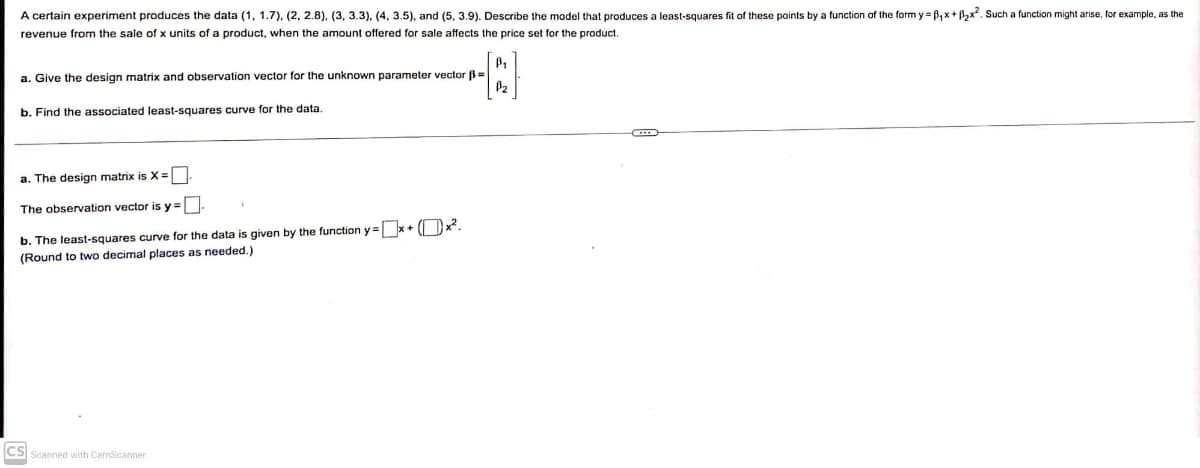A certain experiment produces the data (1, 1.7), (2, 2.8), (3, 3.3), (4, 3.5), and (5, 3.9). Describe the model that produces a least-squares fit of these points by a function of the form y=B₁x + ₂x². Such a function might arise, for example, as the revenue from the sale of x units of a product, when the amount offered for sale affects the price set for the product. a. Give the design matrix and observation vector for the unknown parameter vector = b. Find the associated least-squares curve for the data. a. The design matrix is X= The observation vector is y=. b. The least-squares curve for the data is given by the function y=x+x². (Round to two decimal places as needed.)
A certain experiment produces the data (1, 1.7), (2, 2.8), (3, 3.3), (4, 3.5), and (5, 3.9). Describe the model that produces a least-squares fit of these points by a function of the form y=B₁x + ₂x². Such a function might arise, for example, as the revenue from the sale of x units of a product, when the amount offered for sale affects the price set for the product. a. Give the design matrix and observation vector for the unknown parameter vector = b. Find the associated least-squares curve for the data. a. The design matrix is X= The observation vector is y=. b. The least-squares curve for the data is given by the function y=x+x². (Round to two decimal places as needed.)
Linear Algebra: A Modern Introduction
4th Edition
ISBN:9781285463247
Author:David Poole
Publisher:David Poole
Chapter7: Distance And Approximation
Section7.3: Least Squares Approximation
Problem 31EQ
Related questions
Question
Q5
Please provide justified answer asap to get a upvote

Transcribed Image Text:A certain experiment produces the data (1, 1.7), (2, 2.8), (3, 3.3), (4, 3.5), and (5, 3.9). Describe the model that produces a least-squares fit of these points by a function of the form y=B₁x + ₂x². Such a function might arise, for example, as the
revenue from the sale of x units of a product, when the amount offered for sale affects the price set for the product.
a. Give the design matrix and observation vector for the unknown parameter vector =
b. Find the associated least-squares curve for the data.
a. The design matrix is X=
The observation vector is y=.
b. The least-squares curve for the data is given by the function y=x+x².
(Round to two decimal places as needed.)
CS Scanned with CamScanner
Expert Solution
This question has been solved!
Explore an expertly crafted, step-by-step solution for a thorough understanding of key concepts.
Step by step
Solved in 3 steps with 3 images

Recommended textbooks for you

Linear Algebra: A Modern Introduction
Algebra
ISBN:
9781285463247
Author:
David Poole
Publisher:
Cengage Learning

Elementary Linear Algebra (MindTap Course List)
Algebra
ISBN:
9781305658004
Author:
Ron Larson
Publisher:
Cengage Learning

Linear Algebra: A Modern Introduction
Algebra
ISBN:
9781285463247
Author:
David Poole
Publisher:
Cengage Learning

Elementary Linear Algebra (MindTap Course List)
Algebra
ISBN:
9781305658004
Author:
Ron Larson
Publisher:
Cengage Learning